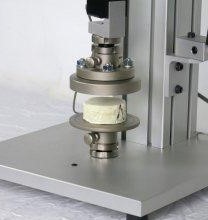
Evaluating static compressive strength characteristics of materials, products, and components
A compression test is any test in which a material experiences opposing forces that push inward upon the specimen from opposite sides or is otherwise compressed, “squashed”, crushed, or flattened. The test sample is generally placed in between two plates that distribute the applied load across the entire surface area of two opposite faces of the test sample and then the plates are pushed together by a universal test machine causing the sample to flatten. A compressed sample is usually shortened in the direction of the applied forces and expands in the direction perpendicular to the force. A compression test is essentially the opposite of the more common tension test.
What is the Purpose of a Compression Test?
The goal of a compression test is to determine the behavior or response of a material while it experiences a compressive load by measuring fundamental variables, such as, strain, stress, and deformation. By testing a material in compression the compressive strength, yield strength, ultimate strength, elastic limit, and the elastic modulus among other parameters may all be determined. With the understanding of these different parameters and the values associated with a specific material it may be determined whether or not the material is suited for specific applications or if it will fail under the specified stresses.
Types of Compression Tests:
In general, a compression test for a material involves at least two opposing forces directed towards each other applied to the opposite face of the test sample so that the sample is compressed. However, there are many different variations to this basic test setup that involve any combination of different variables. The more common compression tests involve forces applied to more than one axis of the specimen as well as the testing of the sample at elevated and lowered temperatures. Uniaxial, biaxial, triaxial, cold temperature, elevated temperature, fatigue and creep are all examples of different compression tests that may be performed upon a material.
Types of Compression Testing Materials:
Typically materials subjected to compression testing have a compressive strength generally accepted to be high and a tensile strength (e.g tensile test) that is considered to be of a lower value. Almost all materials can experience compressive forces in one way or another depending upon their application, but the most common materials are composites, concretes, wood, stone, brick, mortars, grouts, polymers, plastics, foam and metals among many others.
Test Standards
- ASTM D575 Compression Test of Rubber
- ASTM D6641 Compression Testing for Polymer Matrix Composite Laminates
- ASTM D695 Compression Testing for Rigid Plastics
- ASTM D7137 Compressive Residual Strength Test Equipment for Damaged Polymer Matrix Composite Plates
- ASTM D905 Wood Adhesive Bonds in Shear by Compression Loading
- ASTM E9 Compression Testing of Metallic Materials at Room Temperature
- ISO 14126 Compression Fiber-Reinforced Plastic Composites Test Machine
- ISO 1856 Flexible Cellular Polymeric Materials Compression EN
- ISO 604 Compressive Plastics Testing Equipment
- ISO 844 Compressive Strength of Rigid Cellular Plastics
Common Applications
- Compression Force Deflection (CFD) of Flexible Polyurethane Foam per ASTM D3574 Test C
- Compression Test Equipment and Procedures for Cellular Foam
- Compression Test for Steel Stress-Strain | Research Spotlight
- Compression Testing Machine - Biomedical Hydrogels | Research Spotlight
- Compression Testing of Hydraulic Cement Mortars
- Compressive Strength Testing of Dimension Stone
- Electronic Keypad and LCD Compression Testing
- Four Steps to Select Compression Test Equipment for Metals
- Gasket Materials Compression Test Equipment
- How to Select Compression Test Equipment for Ceramics
- Plastic Composite Compression Testing Accessories
- Plastics Composites Compression Test Equipment
- Plastics Compression Testing
- Proppant Crush Test for frack sand, resin-coated sand and ceramic proppant
- Rigid Cellular Plastic Compression Properties (ISO 844 and ASTM D1621)
- Rubber and Elastomer Static and Dynamic Compression
- Rubber Deflection Tests in Compression per ASTM D575 & ISO 7743
- Compression Test of Electronic Components
- Electronic Circuit Board & Components Testing
You Can Pick Your Compression Test Machine in 4 Easy Steps
First, select your frame and actuator(Step 1), then complete your system by selecting your controller software(Step 2) and accessories(Step 3). Choose from a wide range of controller software packages, grips, fixtures, chambers, video extensometers and more, are all designed to perform thousands of ASTM, ISO, EN, DIN and JEDEC industry standard test methods.
When you're ready to complete your system, contact us(Step 4), and an application expert will help you optimize your system to your test requirements and budget.
